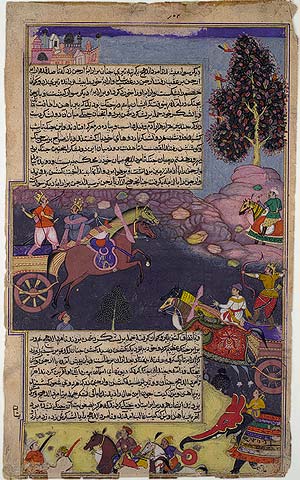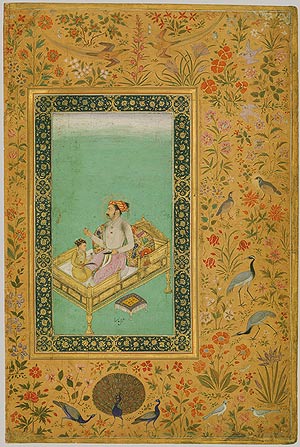Contribute
| Illustrated Books - The Mughal Way |
Ranjani Saigal
03/19/2008
Mughal
painting reflects an exclusive combination of Indian, Persian and
Islamic styles. As the name suggests, these paintings evolved as well as
developed during the rule of Mughal Emperors in India, between 16th to
19th century. The Mughal paintings of India revolved around themes, like
battles, court scenes, receptions, legendary stories, hunting scenes,
wildlife, portraits, etc.
When the second Mughal emperor, Humayun (reigned 1530-1540 and 1555-1556) was in Tabriz in the Safavid court of Shah Tahmasp I, he was exposed to Persian miniature painting. When Humayun returned to India, he brought with him two accomplished Persian artists, Sayyid Ali and Abdus Samad. Their works, and the assimilation of local styles during succeeding decades, gave shape to a distinct style, which became known as Mughal painting.
His son Emperor Akbar is believed to have suffered from some learning disability perhaps dyslexia that prevented him from learning to read. It is well documented that dyslexic people have an in-built aptitude for two-dimensional visual representation and three-dimensional constructs. Perhaps this made him very drawn to the arts. His biography the Akbarnama is one of the most illustrated manuscripts. The Akbarnama is a remarkable work of 116 miniature paintings and is noted for its minute detail. The manuscript gives a picture of the Emperor Akbar's life and times, in both text and illustrations. The illustrations are not merely entertaining but are of unique documentary value. The high degree of modeling of the figures and the realistic recession of the landscape towards the horizon is evidence of the influence of European art, as this is common in the western painting of this period.
Among the important patrons of the early period was Abd al-Rahim Muhammad Khan-i Khanan (1561–1626/7), commander-in-chief of the Mughal armies under both Akbar and Jahangir. A copy of the epic Ramayana (1597–1605)—with 130 illustrations—and six other manuscripts can be attributed to his atelier.
After the death his son Jahangir (r. 1605–27) ascended to the throne. As a prince, Jahangir had established his own atelier in Allahabad and had strong artistic tastes, preferring a single painter to work on an image rather than the collaborative method of Akbar’s time. He also encouraged careful plant and animal studies, and prized realistic portraiture and Europeanized subjects. The books Jahangir commissioned ranged from literary works such as the Razmnama (a Persian translation of the Hindu epic, the Mahabharata) to historical texts, including an illustrated version of the memoirs of his reign, the Tuzuk-i Jahangiri. Many signatures are preserved on works from this period, with such masters as Bishan Das, Manohar, Abu’l-Hasan, Govardhan, and Daulat emerging as recognizable artistic personalities.
Jahangir’s successor Shah Jahan (r. 1628–58) is most celebrated for his architectural achievements, the Taj Mahal being his (and perhaps the country’s) best known monument. Paintings from his reign were characterized by formal portraits and courtly scenes, replacing the more wide-ranging and personal subject matter under Jahangir. The major commission of his reign was a history called the Padshahnama, illustrated through the 1640s.
Unfortunately under the reign of his son, Aurangazeb held a fundamentalist view of Islam and he banned music and art from his courts. This forced artists to seek other patronage and many regional courts benefited greatly from the influx of former imperial employees. Painting at the Hindu Rajasthani courts such as Bikaner, Bundi, and Kota, and at the provincial Muslim courts of Lucknow, Murshidabad, Faizabad, and Farrukhabad, were all transformed as Mughal artists provided fresh inspiration.
You may also access this article through our web-site http://www.lokvani.com/

Razmnama, Mahabharat in Persian

Shahjehan